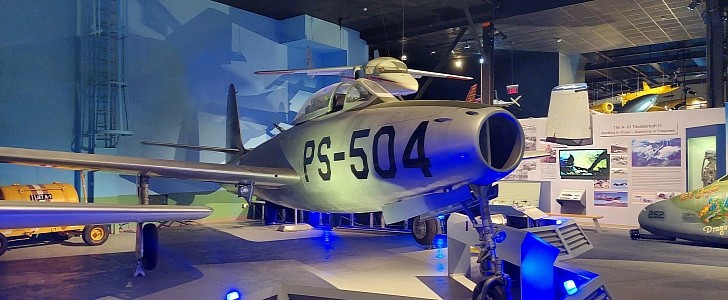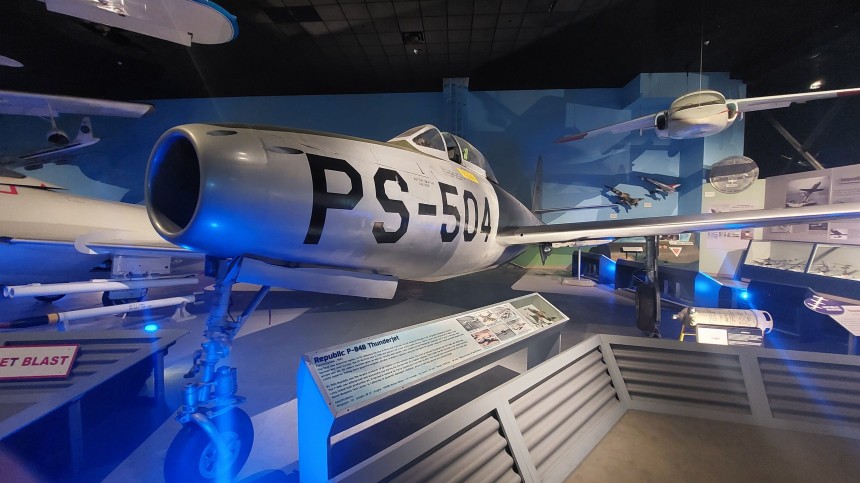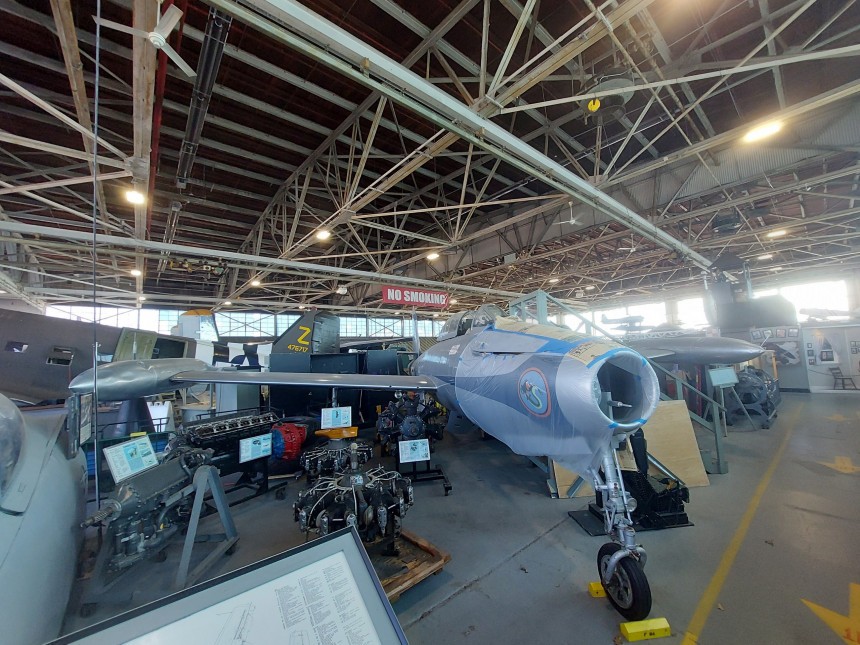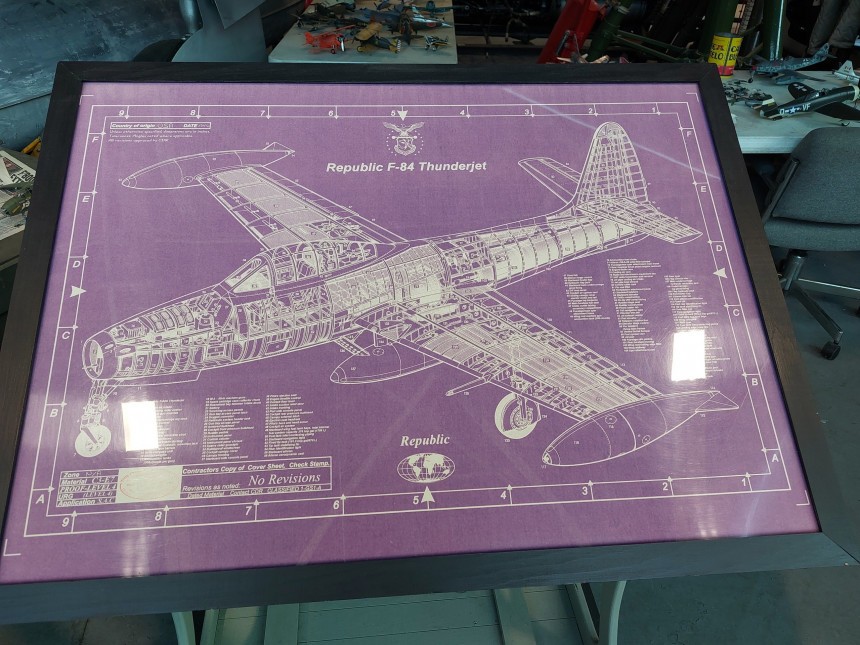If you know anything about Republic Aviation, it's because of one of two airplanes. Either the hellfire raining, 30-mm autocannon sporting A-10 Warthog, or because of its plucky forbearer, the P-47 Thunderbolt.
But on closer analysis, Republic produced more than a few combat and civilian airplanes in their time before being absorbed into the Fairchild corporation in the late 1960s. In between the P-47 and the A-10, the first turbojet aircraft to bear the Republic name embraced the heritage of its ancestors and also set the stage for a memorable and successful future.
The F-84 Thunderjet was one of a handful of landmark American fighter jets that benefited from commandeered German jet engine technology retrieved during the end of the Second World War. Along with the Lockheed P-80 Shooting Star, the North American P-86 Saber, and Grumman F9F Panther, the Thunderjet would be one of the very first American jet fighters ever to see combat.
Like the Lockheed P-80, which beat the Thunderjet into the skies by a couple of years, the P-84 was designed to go toe to toe with Luftwaffe jets like the Messerschmitt Me-262 and Heinkel He-162. Though they both arrived too late for a hypothetical extended air war over Europe, they were just in time for America's next big conflict over Korea. In between WWII and Korea, the newly christened U.S. Air Force officially split from the Army, redesignating the old Army Air Corps' Pursuit designation in favor of F for fighter airplanes.
The Thunderjet also set a U.S. national airspeed record at 607.2 miles per hour (977.1 kph) during the interwar period with an Allison J35 turbojet engine as its propulsion. The first round of F-84B Thunderjets proved to be superior in some aspects to the F-80 Shooting Star, mostly in the fields of range and top speed. The Thunderjet's six M2 Browning .50 cal made the F-84B a potent jet fighter. It also proved an admirable bomber escort during the early years of the Korean War at a time when the F-86 Saber was experiencing developmental delays.
With thick straight wings, pilots seldom took the Thunderjet much past 0.82 Mach at low to medium altitudes. Lest the airframe was pushed any harder, leading to the wings ripping from the fuselage. As combat hours were racked up, it was found that the F-84 could fly even faster at altitudes past 25,000 feet, potentially to as high as 0.92 Mach. Whether it could have actually challenged the Mach 1 barrier is doubtful but not entirely implausible. It appears no pilot was brave or foolish enough to find out.
Over the course of the Korean War and soon afterward, the Thunderjet underwent a slew of upgrades and modifications to squeeze as much life out of an admittedly antiquated straight-winged jet fighter. Culminating in the top of the range F-84G, complete with added aerodynamic winglets attached to either of the wing-mounted tip-tanks. This was complemented upgrades to the airplane's J37 by a Sadly, a lack of more advanced swept wings left the Thunderjet vulnerable to the mighty Mikoyan-Gurevich MiG-15.
Though the F-84 wasn't a complete sitting duck against more advanced Soviet Jets, they were clearly at a disadvantage in all but the situations the Thunderjet had the numbers of altitude advantage. There were a few instances of Thunderjets shooting down MiG-15s, as many as ten that we can verify. Most of these occurred as a MiG was taking off or landing, but it was a whole different story at normal dogfighting altitudes. In that realm, the F-84 was simply outmatched.
But as for combat against ground targets, the story is a full 180 reversal. It's estimated as much as 60 percent of all ground vehicles, artillery, and armored pillbox entrenchments destroyed by United Nations forces in the Korean War fell at the hands of the Thunderjet. Soviet Built T-34s and IS-2 tanks frequently found themselves turned to paste by barrages of bombs and tube-mounted rockets.
The F84G was the first American jet fighter capable of carrying a nuclear bomb, among its innumerable other accomplishments. The type would serve with Air Forces across the Globe, from Brazil and Mexico to Yugoslavia and Thailand, alongside its American operations.
With respectable dogfighting ability, outstanding ground and pound capability, and a loyal following of pilots who loved to fly in them, the Thunderjet is perhaps the most versatile American jet fighter of the early Cold War. Today, you can see both ends of the Thunderjet lineage a mere 12 miles (19 km) apart from one another.
The Cradle of Aviation Museum in Garden City, Long Island, New York, has an early P-84A on display next to a similarly aged Grumman F9 Cougar. The type would serve with Air Forces across the Globe from Brazil and Mexico to Yugoslavia and Taiwan. Many examples are on display in these countries as well.
Just east of here, the American Airpower Museum in nearby Farmingdale has an F-84G in its collection. When compared back to back with one, it's like looking at Darwin's theory of evolution on a mechanical level. The former certainly lead the path for the latter in the case of the Thunderjet. It helped lay the groundwork for a future Republic attack plane with a gun that makes a certain unmistakable sound.
Thanks for checking out our coverage from the Cradle of Aviation Museum right here on autoevolution.
The F-84 Thunderjet was one of a handful of landmark American fighter jets that benefited from commandeered German jet engine technology retrieved during the end of the Second World War. Along with the Lockheed P-80 Shooting Star, the North American P-86 Saber, and Grumman F9F Panther, the Thunderjet would be one of the very first American jet fighters ever to see combat.
Like the Lockheed P-80, which beat the Thunderjet into the skies by a couple of years, the P-84 was designed to go toe to toe with Luftwaffe jets like the Messerschmitt Me-262 and Heinkel He-162. Though they both arrived too late for a hypothetical extended air war over Europe, they were just in time for America's next big conflict over Korea. In between WWII and Korea, the newly christened U.S. Air Force officially split from the Army, redesignating the old Army Air Corps' Pursuit designation in favor of F for fighter airplanes.
The Thunderjet also set a U.S. national airspeed record at 607.2 miles per hour (977.1 kph) during the interwar period with an Allison J35 turbojet engine as its propulsion. The first round of F-84B Thunderjets proved to be superior in some aspects to the F-80 Shooting Star, mostly in the fields of range and top speed. The Thunderjet's six M2 Browning .50 cal made the F-84B a potent jet fighter. It also proved an admirable bomber escort during the early years of the Korean War at a time when the F-86 Saber was experiencing developmental delays.
Over the course of the Korean War and soon afterward, the Thunderjet underwent a slew of upgrades and modifications to squeeze as much life out of an admittedly antiquated straight-winged jet fighter. Culminating in the top of the range F-84G, complete with added aerodynamic winglets attached to either of the wing-mounted tip-tanks. This was complemented upgrades to the airplane's J37 by a Sadly, a lack of more advanced swept wings left the Thunderjet vulnerable to the mighty Mikoyan-Gurevich MiG-15.
Though the F-84 wasn't a complete sitting duck against more advanced Soviet Jets, they were clearly at a disadvantage in all but the situations the Thunderjet had the numbers of altitude advantage. There were a few instances of Thunderjets shooting down MiG-15s, as many as ten that we can verify. Most of these occurred as a MiG was taking off or landing, but it was a whole different story at normal dogfighting altitudes. In that realm, the F-84 was simply outmatched.
But as for combat against ground targets, the story is a full 180 reversal. It's estimated as much as 60 percent of all ground vehicles, artillery, and armored pillbox entrenchments destroyed by United Nations forces in the Korean War fell at the hands of the Thunderjet. Soviet Built T-34s and IS-2 tanks frequently found themselves turned to paste by barrages of bombs and tube-mounted rockets.
With respectable dogfighting ability, outstanding ground and pound capability, and a loyal following of pilots who loved to fly in them, the Thunderjet is perhaps the most versatile American jet fighter of the early Cold War. Today, you can see both ends of the Thunderjet lineage a mere 12 miles (19 km) apart from one another.
The Cradle of Aviation Museum in Garden City, Long Island, New York, has an early P-84A on display next to a similarly aged Grumman F9 Cougar. The type would serve with Air Forces across the Globe from Brazil and Mexico to Yugoslavia and Taiwan. Many examples are on display in these countries as well.
Just east of here, the American Airpower Museum in nearby Farmingdale has an F-84G in its collection. When compared back to back with one, it's like looking at Darwin's theory of evolution on a mechanical level. The former certainly lead the path for the latter in the case of the Thunderjet. It helped lay the groundwork for a future Republic attack plane with a gun that makes a certain unmistakable sound.














